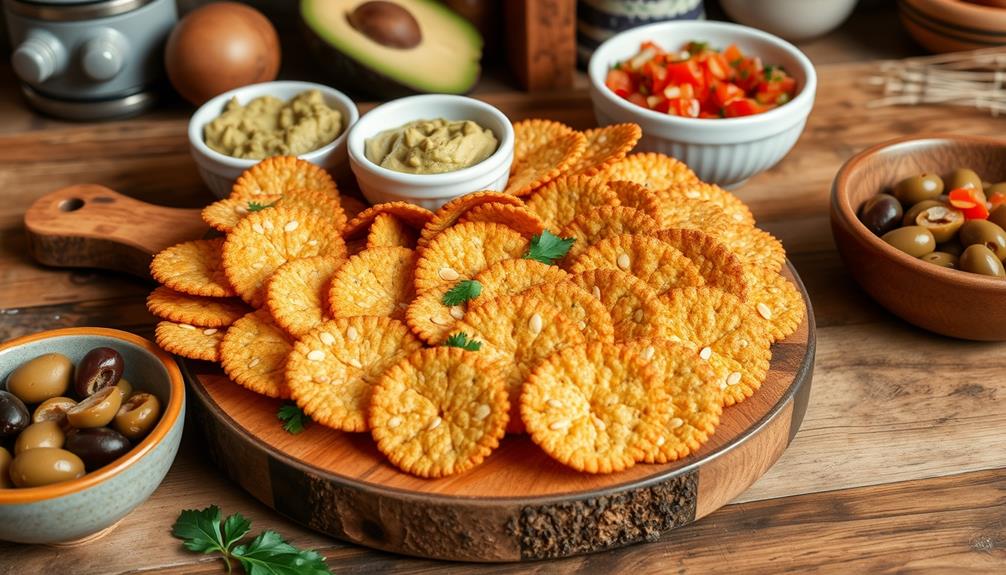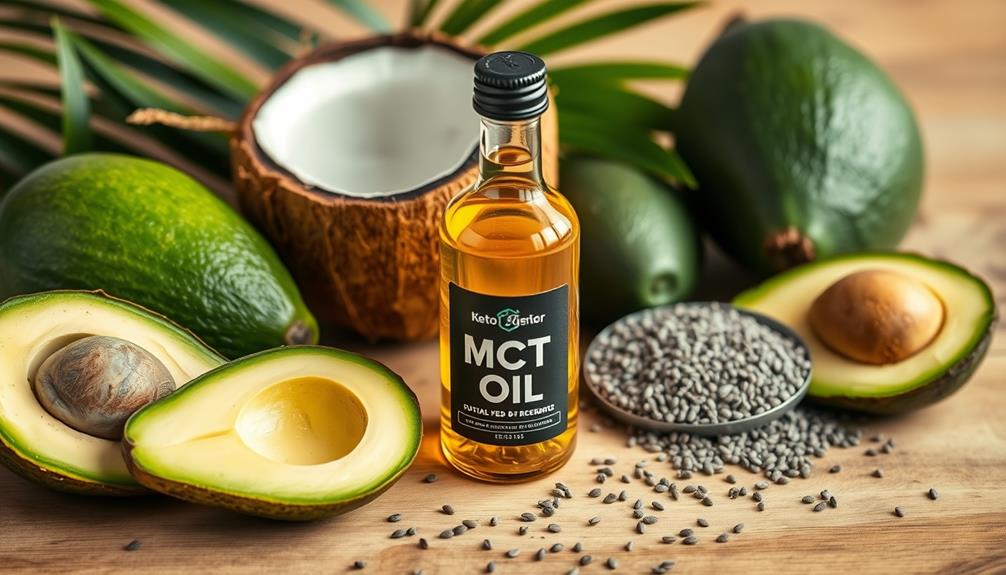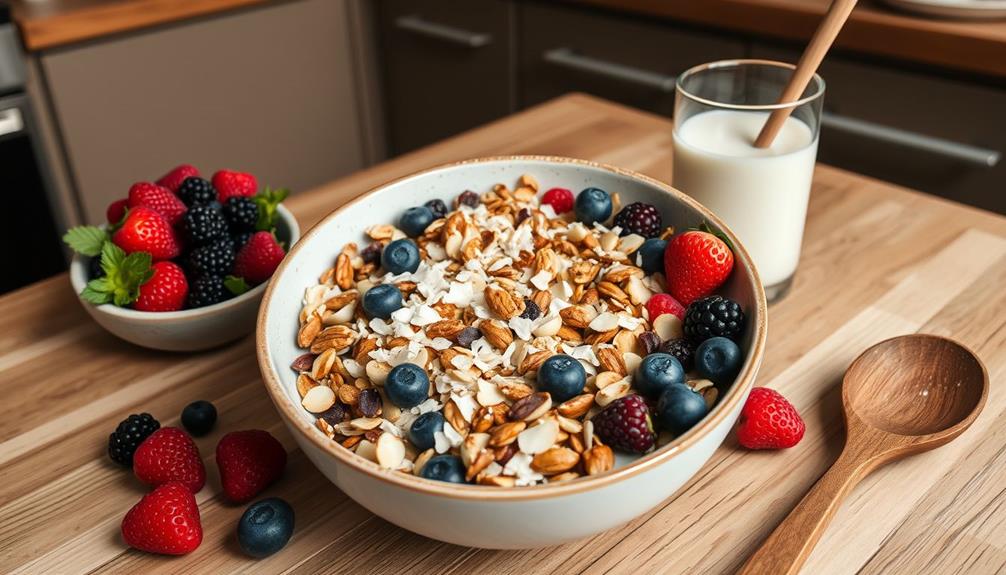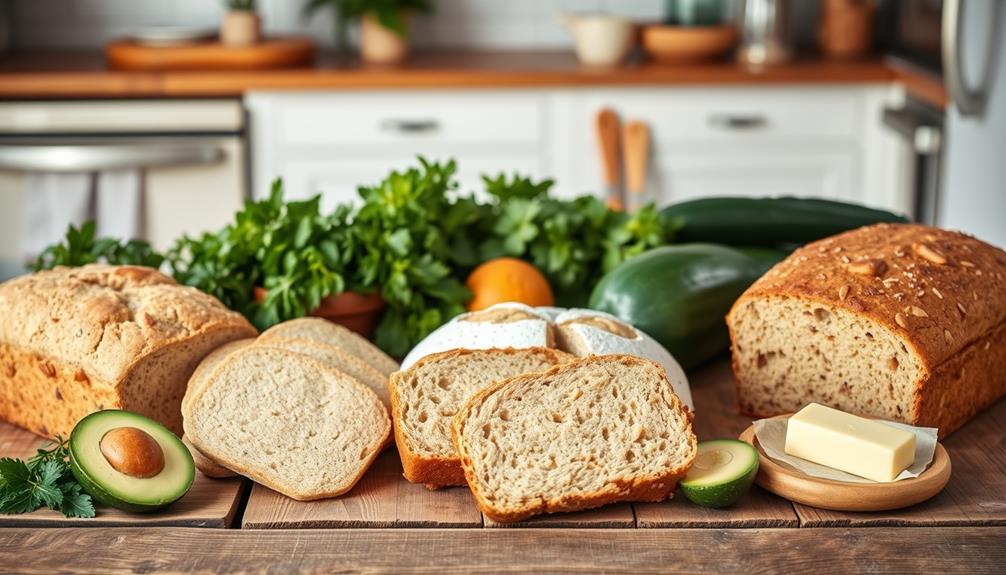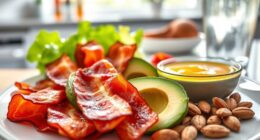If you're on a keto diet, low carb crackers are your best bet to satisfy cravings without kicking you out of ketosis. Aim for options with less than 5g of net carbs per serving, like Julian Bakery Primal Thin Crackers or Fat Snax Almond Flour Crackers. These snacks typically contain high fiber from ingredients like almond flour or flaxseed, promoting digestive health. Plus, they offer a range of flavors to keep things interesting. Choose those with minimal processing and natural ingredients to enhance your diet. Stick around, and you'll discover even more delicious keto-friendly options.
Key Takeaways
- Look for low carb crackers with less than 5g of net carbs per serving to maintain ketosis effectively.
- Choose crackers with at least 2g of fiber and over 5g of protein for better satiety and muscle support.
- Opt for products made from natural ingredients like almond flour and flaxseed, avoiding added sugars and artificial additives.
- Popular options include Julian Bakery Primal Thin Crackers and Quest Cheese Crackers, offering great taste and nutritional benefits.
- Store crackers in an airtight container and keep them in a cool, dry place to maintain freshness and crunch.
Overview of Low Carb Crackers
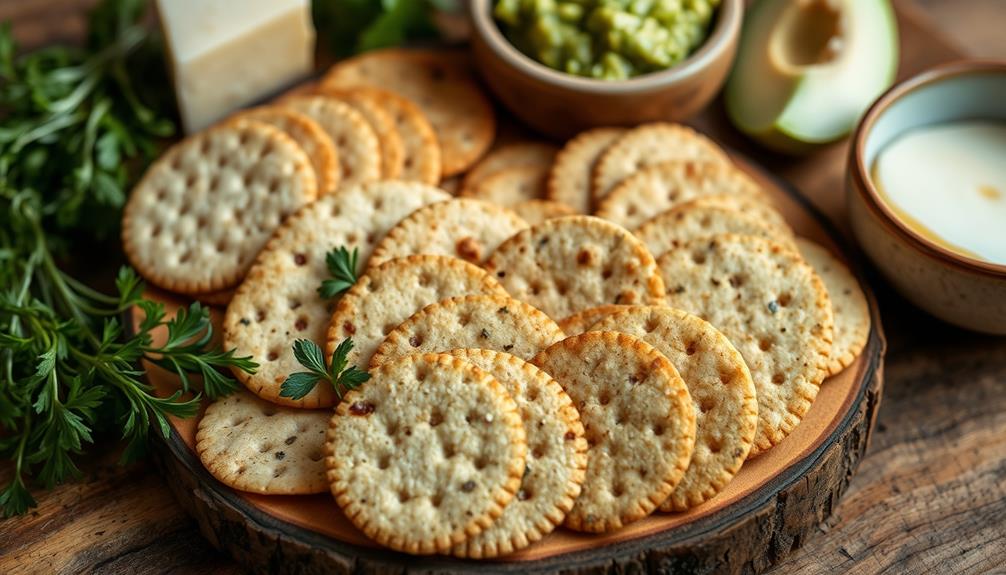
When it comes to snacking on a keto diet, low carb crackers are a game-changer. These tasty treats typically contain less than 5g of net carbs per serving, making them perfect for your ketogenic lifestyle.
You'll find a variety of options, including those made from almond flour, flaxseed, and unique seed blends. Not only do these ingredients keep the carb count low, but they also provide a high fiber content that can help you feel full longer.
Brands like Julian Bakery Primal Thin Crackers are excellent choices, offering 4.5g of fat and just 5g of net carbs per serving. This combination promotes satiety, which is essential for weight loss on a keto diet.
Plus, many of these low carb crackers are gluten-free, containing minimal ingredients that cater to various dietary restrictions.
Whether you're looking for a crunchy snack to pair with your favorite dip or a quick munch between meals, Keto Crackers can fit seamlessly into your routine.
Nutritional Insights and Benefits

Low carb crackers offer a wealth of nutritional benefits that can enhance your keto journey. Typically low in net carbs, with fewer than 5g per serving, these crackers help you maintain ketosis while satisfying your snack cravings.
Their high fiber content promotes digestive health and increases feelings of fullness, making it easier to control your appetite. Incorporating protein-rich options, many low carb crackers can support muscle maintenance and overall satiety, which is essential for effective weight management.
Almond flour crackers, for example, aren't only delicious but also provide a nutritious snack option that fits perfectly into your keto lifestyle. Additionally, these crackers often contain healthy fats, thanks to ingredients like flaxseed and almond flour, which support heart health and provide lasting energy.
Choosing low carb crackers that are minimally processed and free from sugar and artificial additives can further reduce inflammation and promote overall health. By incorporating these nutritious snacks into your diet, you'll not only enjoy a tasty treat but also reap the multiple benefits that align with your keto goals.
Selection Criteria for Crackers
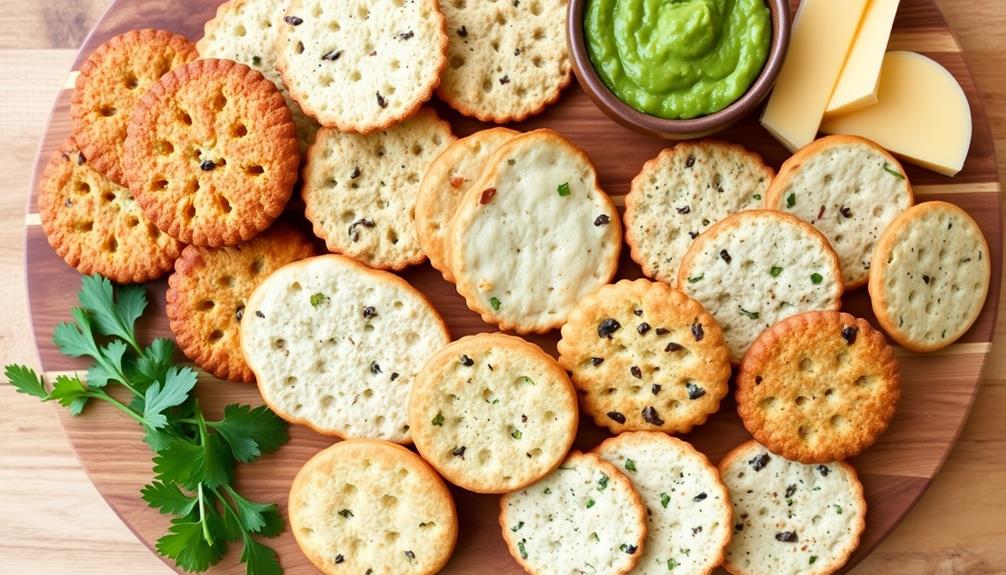
When you're picking crackers for your keto diet, focus on the macronutrient balance to keep your carb intake low.
Look for high-quality ingredients that not only limit net carbs but also provide healthy fats and proteins.
This way, you can enjoy your snacks while sticking to your dietary goals.
Macronutrient Balance
Selecting the right crackers for a keto diet hinges on achieving an ideal macronutrient balance.
You'll want to focus on several key factors to make sure your choices align with your dietary goals. Look for crackers that support ketosis while providing essential nutrients.
When evaluating potential options, keep these criteria in mind:
- Less than 5g of net carbs per serving: This helps maintain ketosis effectively.
- At least 2g of fiber per serving: High fiber enhances satiety and supports digestive health.
- Over 5g of protein per serving: A higher protein content aids in muscle maintenance and keeps hunger at bay.
- At least 5g of healthy fats per serving: Healthy fats are critical for energy and satiety on a keto diet.
- Ingredient quality: Always prioritize whole food ingredients, like almond flour, without added sugars or artificial additives.
Ingredient Quality Standards
Focusing on ingredient quality is vital for choosing the best crackers on a keto diet. Start by examining the ingredient list; look for natural components like almond flour or flaxseed. These ingredients not only provide a wholesome blend of almond but also deliver high fiber and healthy fats, essential for maintaining ketosis.
Make certain to avoid any products with added sugars or artificial sweeteners. Instead, prioritize crackers with minimal additives to help reduce inflammation and support overall health. It's wise to choose options that have less than 5g net carbs per serving to align with ketogenic dietary guidelines.
If you follow specific dietary preferences, consider gluten-free or vegan certifications. This guarantees inclusivity for various dietary needs and enhances your snacking experience.
Lastly, review the ingredient quality by steering clear of preservatives or unfamiliar components. Opt for crackers made with whole food ingredients that fit seamlessly into your keto lifestyle.
Popular Low Carb Cracker Options
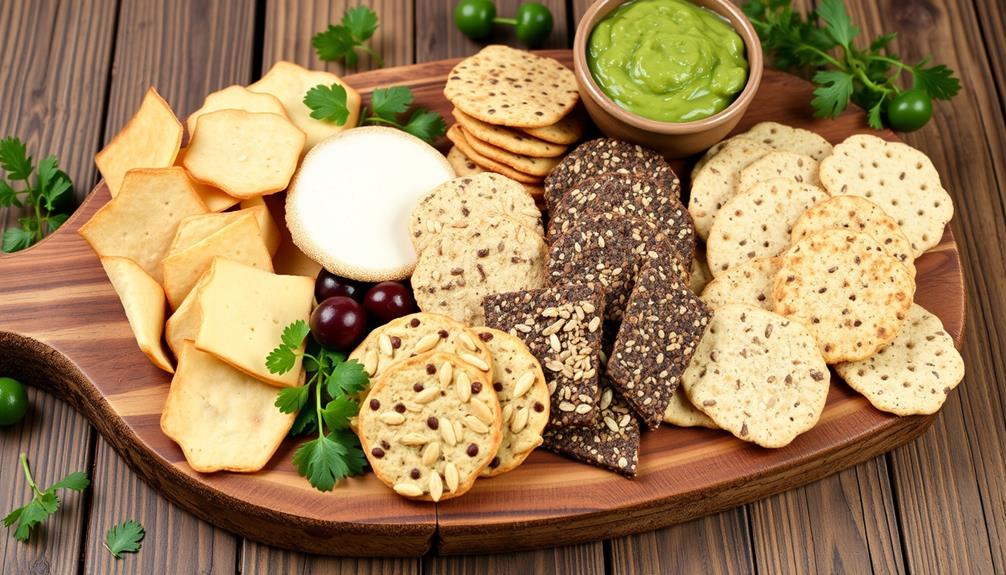
If you're looking to satisfy your cravings without derailing your keto diet, there are several popular low carb cracker options that fit the bill.
These choices not only keep your carb count low but also deliver on taste and texture, making them perfect for snacking.
Here are five top contenders:
- Julian Bakery Primal Thin Crackers: With only 5g net carbs and 70 calories per serving, these almond flour and seed-based crackers are great for weight loss.
- Quest Cheese Crackers: A savory option that packs 10g of protein and 10g of carbs, ideal for crunchy munching.
- ELLAS FLATS® Sesame Savory Crisps: These seed-based crisps provide just 4g net carbs and 8g protein, making them a nutritious choice.
- Fat Snax Almond Flour Crackers: Perfect for dipping, they contain only 2g net carbs and 130 calories per serving.
- Hu Kitchen Paleo Vegan Crackers: Catering to vegan diets, these crackers have 9g net carbs and come in various flavors.
These options will keep you on track while satisfying your snack cravings!
Ingredient Quality Assessment
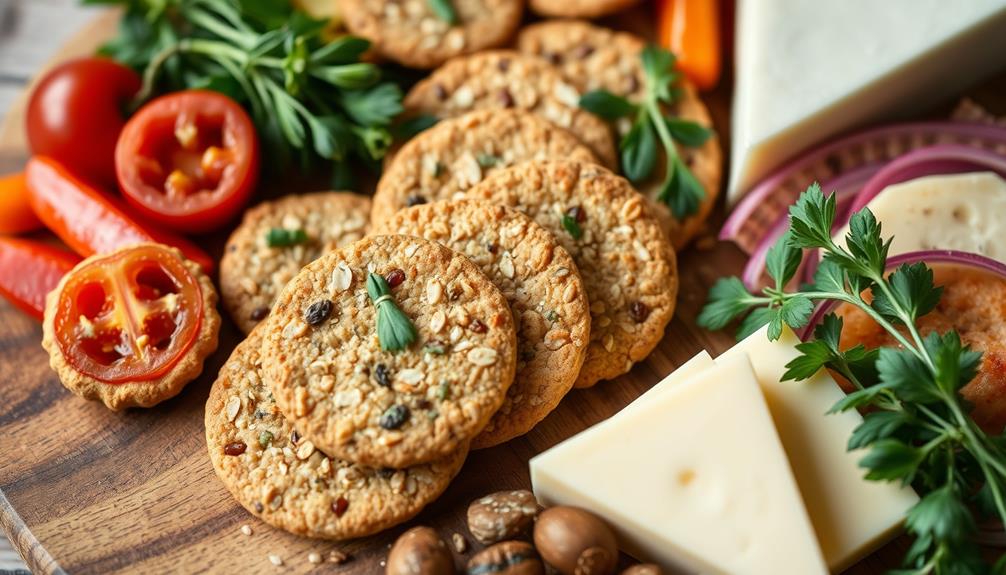
When evaluating keto-friendly crackers, it's important to sift through the ingredient list to ascertain you're choosing options that align with your health goals. Focus on crackers made from whole food ingredients like almond flour or flaxseed. These ingredients not only provide a low-carb option but also ascertain high fiber content and minimal processing.
Avoid crackers that contain artificial additives, preservatives, and refined sugars. These can undermine the integrity of your healthy keto diet. Instead, look for gluten-free options, especially if you have sensitivities, as they can seamlessly fit into a low-carb lifestyle.
Assess the nutrient density of the crackers by checking for ingredients rich in healthy fats, proteins, and essential vitamins and minerals. This will help you make a more informed choice.
Be diligent in reading product labels to confirm the absence of unhealthy oils and ascertain that net carbs remain low, ideally under 5g per serving. Prioritizing ingredient quality not only supports your keto journey but also promotes overall health, making it easier to stick to your diet while enjoying your snacks.
Taste and Texture Evaluation
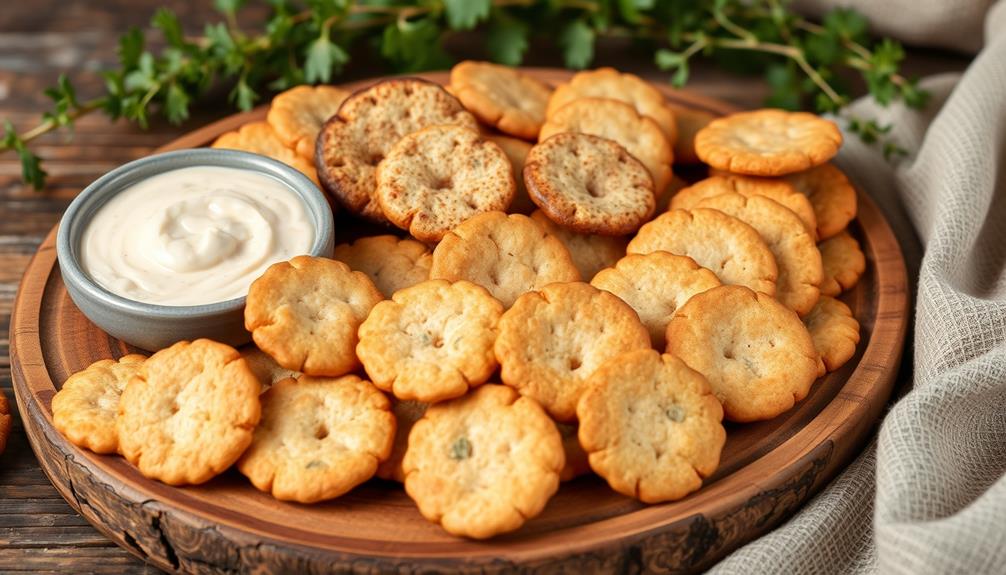
Ingredient quality is just one aspect of choosing the right keto crackers; taste and texture play a significant role in your overall snacking experience.
When selecting low-carb crackers, it's crucial to reflect on how they feel and taste in your mouth. A satisfying crunch can elevate your enjoyment, making you reach for more.
Here are some key factors to keep in mind:
- Flavor Variety: Look for options like Hu Crackers, which offer unique flavors such as sea salt and everything bagel.
- Crunch Factor: Brands like Whisps Cheese Crisps deliver an appealing crunch that many consumers adore.
- Mouthfeel: Ponder the sturdiness of seed-based crackers like ELLAS FLATS® Sesame Savory Crisps, perfect for dipping.
- Taste Satisfaction: Customers rave about Quest Cheese Crackers, known for their delicious cheese flavor and high protein content.
- Feedback: Regularly check for updated reviews as brands may tweak their recipes, impacting taste and texture.
When you focus on these elements, you'll enhance your keto snacking experience while enjoying delicious, low-carb options.
Storage Tips for Crackers
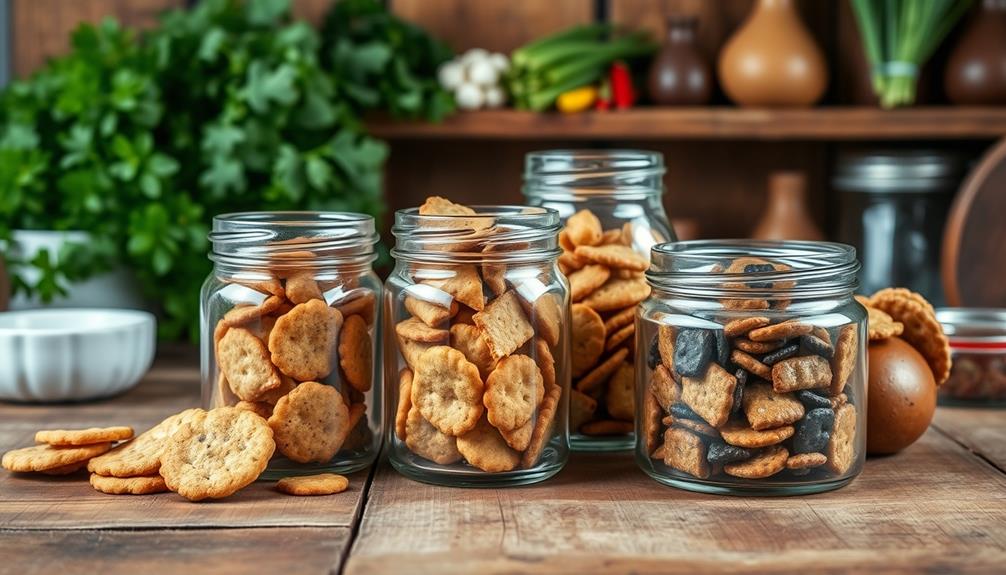
To keep your low carb crackers fresh, store them in an airtight container or a zip-loc bag.
This simple step prevents moisture from ruining their texture.
If you want to extend their shelf life, consider refrigeration, but always check the packaging for any specific instructions.
Airtight Container Storage
Storing low carb crackers in an airtight container is essential for keeping their delightful crunch and preventing any moisture from turning them soggy.
An airtight container not only protects your crackers but can also extend their shelf life, ensuring they stay fresh for up to a week at room temperature.
To maximize freshness, consider the following storage tips:
- Choose a container with a tight seal to keep air and moisture out.
- Store crackers in a cool, dry place away from direct sunlight.
- Always check the packaging for specific storage instructions from the manufacturer.
- If your crackers lose their crunch, revive them by reheating in an oven or toaster oven.
- Consider refrigeration for crackers made with natural ingredients to prolong freshness.
Following these tips will help you enjoy your low carb crackers at their best.
Refrigeration for Freshness
Refrigeration can be a game-changer for keeping your low carb crackers fresh, especially if they contain perishable ingredients. By storing them in the fridge, you can greatly extend their shelf life beyond the typical one week you'd get at room temperature.
Just be certain to check the packaging for specific storage instructions, as some crackers may have unique needs.
To maintain ideal freshness, always use an airtight container or a zip-loc bag. This prevents moisture from seeping in, which can lead to sogginess and ruin that delightful crunch.
If you notice your crackers have lost their texture, don't despair! A quick reheat in the oven or toaster oven for a few minutes can help revive their original crunchiness.
Keep an eye on the expiration date, and try to consume your crackers within the recommended timeframe to guarantee the best taste and quality.
Macros Considerations

When choosing crackers for a keto diet, it's crucial to evaluate their macronutrient profile carefully. This will help you stay in ketosis while enjoying your snacks.
Here are some key considerations to keep in mind:
- Net Carbs: Aim for options with less than 5g of net carbs per serving to maintain ketosis effectively.
- Fiber Content: Look for crackers with a high fiber content, ideally over 5g, to aid digestion and keep you feeling full.
- Protein Levels: Select products with at least 3g of protein per serving to support muscle maintenance and increase satiety.
- Healthy Fats: Choose crackers that contain balanced healthy fats, which are important for energy and satisfaction on a ketogenic diet.
- Caloric Count: Pay attention to the caloric count; lower-calorie options can assist with weight management while still providing necessary nutrients.
Health Benefits of Low Carb Crackers
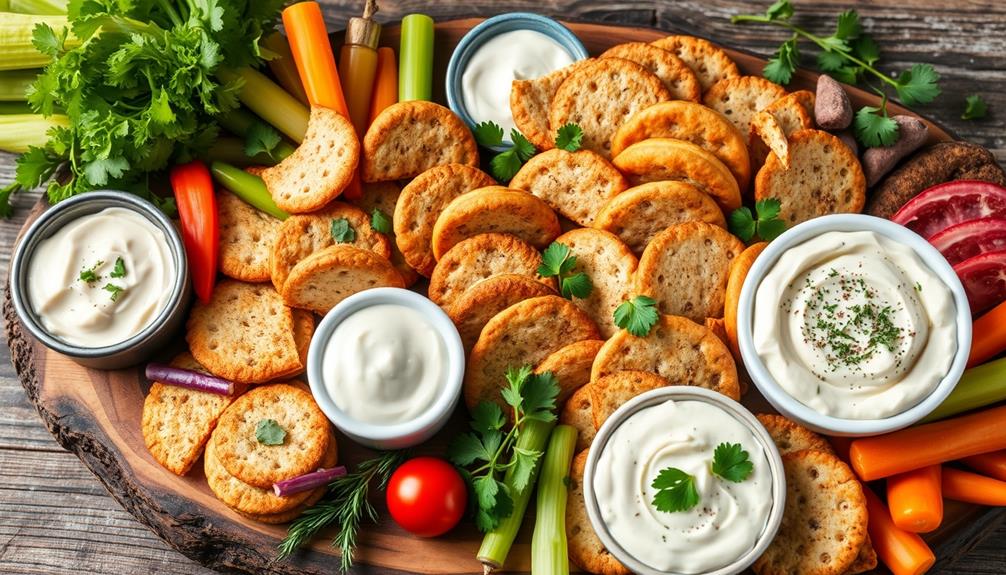
Low carb crackers offer several nutritional advantages that make them a smart choice for your keto diet.
They're high in fiber, which not only helps you feel full but also supports healthy digestion.
Plus, by keeping your blood sugar stable, these crackers can help curb cravings and keep your energy levels steady throughout the day.
Nutritional Advantages Overview
Many people find that incorporating low carb crackers into their diet brings numerous nutritional advantages, particularly for those following a keto lifestyle.
These crackers aren't only a satisfying snack but also offer a range of health benefits that support your overall wellness.
Here are some key nutritional advantages of low carb crackers:
- Low Carb Content: With less than 5g of net carbs per serving, they help maintain ketosis.
- High Fiber: Their fiber-rich ingredients promote digestion and a feeling of fullness.
- Nutrient-Dense Ingredients: Many are made with almond flour and flaxseed, providing healthy fats for heart health.
- Blood Sugar Stability: Their low carb nature helps stabilize blood sugar levels, making them suitable for those with diabetes.
- Minimally Processed Options: Choosing low carb crackers that are minimally processed can reduce inflammation and prevent nutrient deficiencies.
Fiber and Satiety Benefits
There's no denying that fiber plays an essential role in your diet, especially when it comes to low carb crackers. These snacks often boast high fiber content, which can greatly promote feelings of fullness. This helps you reduce overall calorie intake throughout the day, making it easier to stick to your keto goals.
Many low carb cracker options have net carbs under 5g per serving, making them perfect for maintaining ketosis while providing that satisfying crunch.
Incorporating snacks high in protein and fiber, like seed-based and almond flour crackers, can effectively curb your appetite. Research shows that these fiber-rich snacks lower hunger hormones, which can lead to less snacking and more control over your food choices.
Plus, the fiber in these crackers aids digestion, further enhancing your weight loss efforts.
Blood Sugar Stabilization Effects
When you're on a keto diet, choosing the right snacks can make a significant difference in how you manage your blood sugar levels. Low carb crackers are an excellent option, as they often contain less than 5g of net carbs per serving. This helps stabilize blood sugar levels and minimizes insulin spikes that typically occur with high carbohydrate foods.
Here are some benefits of incorporating low carb crackers into your diet:
- High fiber content: Promotes satiety and can reduce overall calorie intake.
- Protein-rich ingredients: Ingredients like cheese or seeds slow down carbohydrate absorption.
- No added sugars: Perfect for maintaining stable blood sugar levels, especially for diabetics.
- Improved metabolic health: Regular consumption can help prevent blood sugar fluctuations.
- Convenient snacking: Easy to grab and enjoy on-the-go without compromising your diet.
Reader Engagement and Resources

Engaging with fellow keto enthusiasts can enhance your journey on the low carb lifestyle, and there are several ways to connect with the community.
Start by diving into the comments section of articles to share your personal experiences and favorite low carb crackers. This interaction not only fosters reader engagement but can also help you discover new brands and products.
Don't forget to explore articles on health topics related to keto. You'll find valuable resources for purchasing keto-friendly products directly from the site. Staying updated with regular product news guarantees you're in the loop about new launches and trends in low carb snacking.
Sign up for newsletters to receive exclusive recipes, product news, and promotional offers tailored for keto lovers like you. This way, you won't miss out on exciting additions to your meal plan.
If you have any questions about payment options or product details, utilize customer support for a smooth shopping experience. Engaging with the keto community and accessing these resources will greatly enrich your low carb journey.
Frequently Asked Questions
What Kind of Crackers Can I Have on the Keto Diet?
You can enjoy crackers made from almond flour, coconut flour, or flaxseed on the keto diet. Look for options with low net carbs, high fiber, and minimal additives to support your health goals. Some of the best ketofriendly snacks to pair with these crackers include vegetables with guacamole, cheese cubes, and nitrate-free deli meats. These options provide a balanced mix of healthy fats, protein, and minimal carbohydrates to keep you satisfied and on track with your keto goals. Always remember to keep an eye on portion sizes, as even the healthiest snacks can add up in calories and macros.
Are Ritz Crackers Low-Carb?
Ritz crackers aren't low-carb. With about 18 grams of carbs per serving, they exceed typical keto limits. You should opt for lower-carb alternatives, like almond flour or seed-based crackers, to stay within your dietary goals.
Can I Eat One Cracker on Keto?
Yes, you can eat one cracker on keto if it's low in net carbs. Just keep track of your daily intake, and remember moderation is key to maintaining ketosis and achieving your diet goals.
What Is a Keto Substitute for Chips or Crackers?
Did you know some cheese crisps contain only 1-3g net carbs? You can swap traditional chips with almond flour crackers, flaxseed options, or even veggie-based snacks to satisfy your crunch cravings while staying keto-friendly.
Conclusion
In your journey on the keto diet, choosing the right low carb crackers can make all the difference. By selecting quality ingredients, monitoring your macros, and enjoying the health benefits, you're setting yourself up for success. So, savor the crunch, relish the flavors, and indulge in guilt-free snacking. Remember, it's not just about what you eat, but how it fits into your lifestyle. Stay informed, stay satisfied, and keep those cravings at bay!
